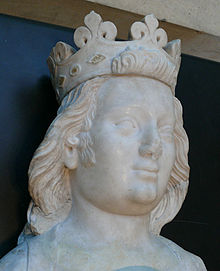Charles IV of France
| Charles the Fair | |
|---|---|
 |
|
| King of France | |
| Reign | 3 January 1322 – 1 February 1328 |
| Coronation | 21 February 1322 |
| Predecessor | Philip V |
| Successor | Philip VI |
| King of Navarre | |
| Reign | 3 January 1322 – 1 February 1328 |
| Predecessor | Philip II |
| Successor | Joan II |
| Born | 18/19 June 1294 Clermont, Oise, France |
| Died | 1 February 1328 (aged 33) Vincennes, France |
| Burial | Saint Denis Basilica |
| Spouse |
Blanche of Burgundy Marie of Luxembourg Jeanne d'Évreux |
| Issue | Blanche, Duchess of Orléans |
| House | Capet |
| Father | Philip IV of France |
| Mother | Joan I of Navarre |
| Religion | Roman Catholicism |
Charles IV (Clermont 18/19 June 1294 – Vincennes 1 February 1328), called the Fair (le Bel) in France and the Bald (el Calvo) in Navarre, was the last direct Capetian King of France and King of Navarre (as Charles I) from 1322 to his death. Charles was the third son of Philip IV; like his father, he was known as "the fair" or "the handsome".
Beginning in 1323 Charles was confronted with a peasant revolt in Flanders, and in 1324 he made an unsuccessful bid for the elective German monarchy. As duke of Guyenne, King Edward II of England was a vassal of Charles, but he was reluctant to pay homage to another king. In retaliation, Charles conquered the Duchy of Guyenne in a conflict known as the War of Saint-Sardos (1324). In a peace agreement, Edward II accepted to swear allegiance to Charles and to pay a fine. In exchange, Guyenne was returned to Edward but with a much-reduced territory.
When Charles IV died without male heir, the senior lineage of the House of Capet ended. He was succeeded by his cousin Philip of Valois, but the contested legitimacy was one factor of the Hundred Years' War.
By virtue of the birthright of his mother, Joan I of Navarre, Charles claimed the title Charles I, King of Navarre. From 1314 to his accession to the throne, he held the title of Count of La Marche and was crowned King of France in 1322 at the cathedral in Reims. Unlike Philip IV and Philip V, Charles is reputed to have been a relatively conservative, "strait-laced" king – he was "inclined to forms and stiff-necked in defence of his prerogatives", while disinclined either to manipulate them to his own ends or achieve wider reform.
...
Wikipedia
